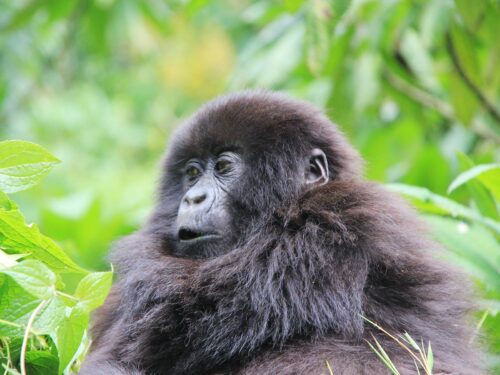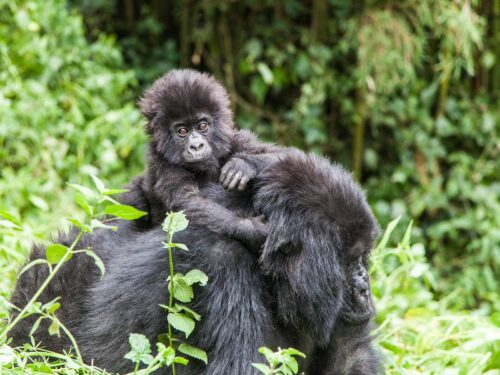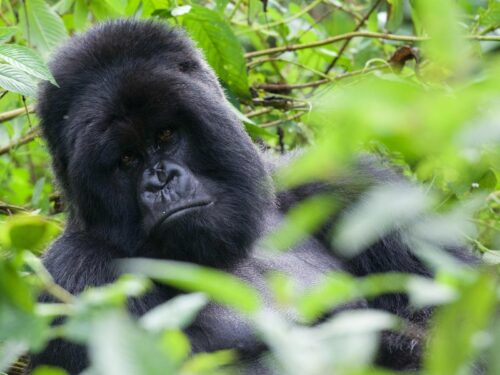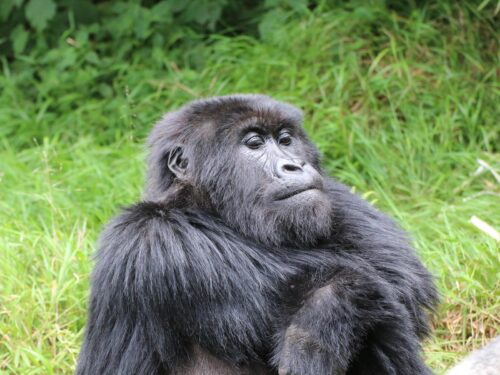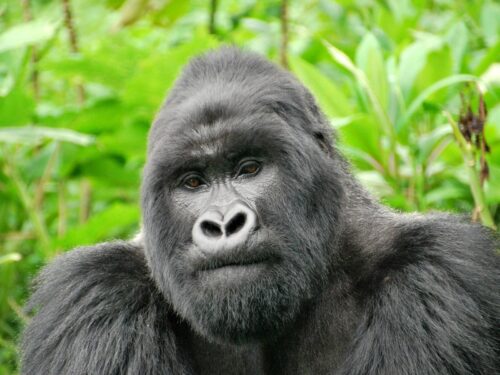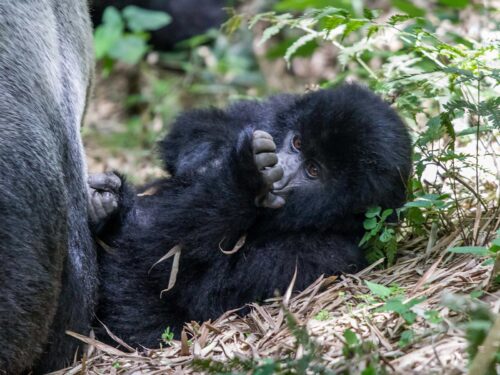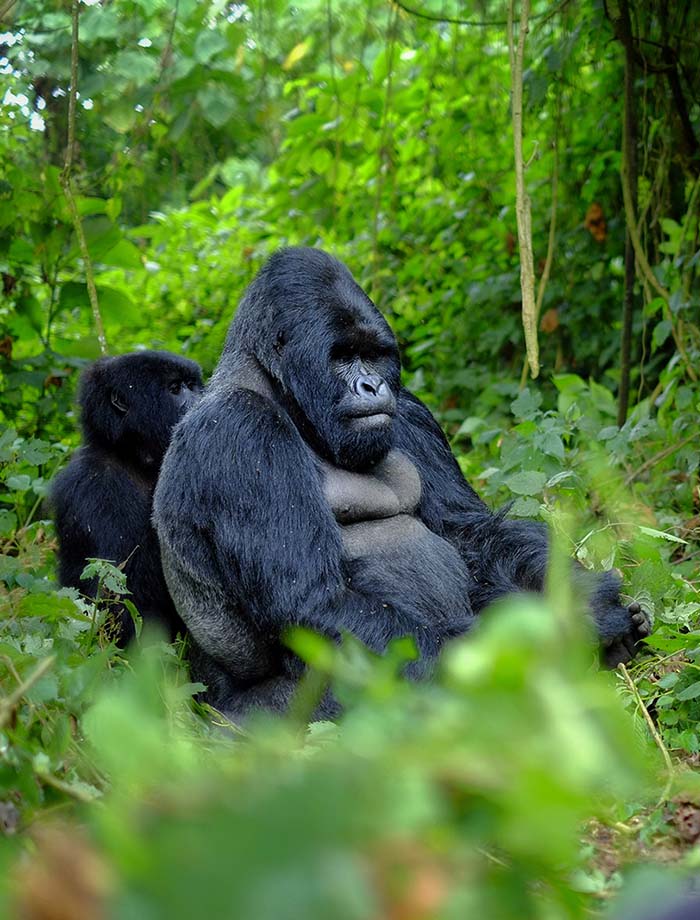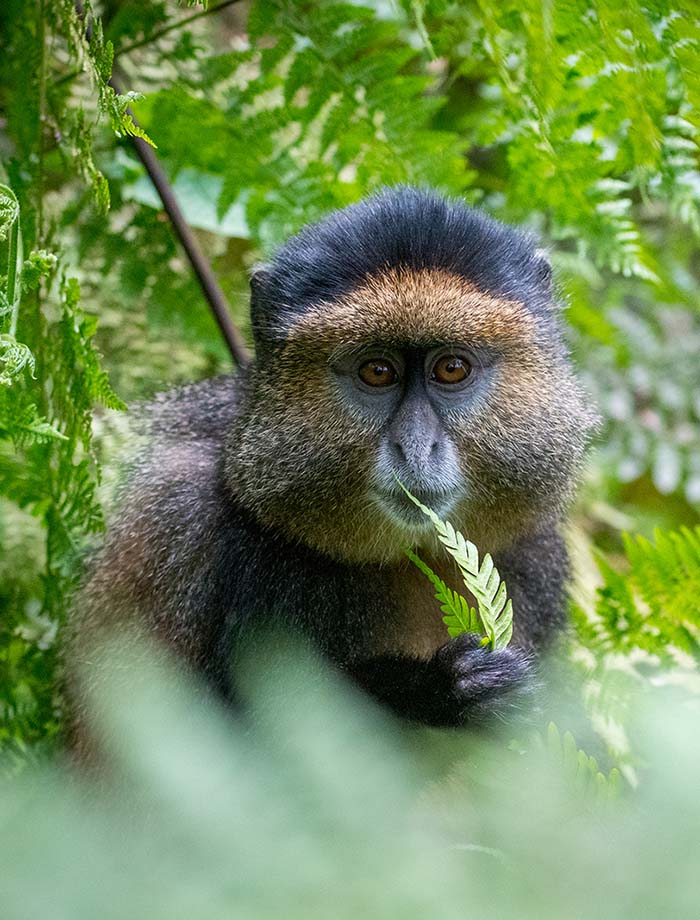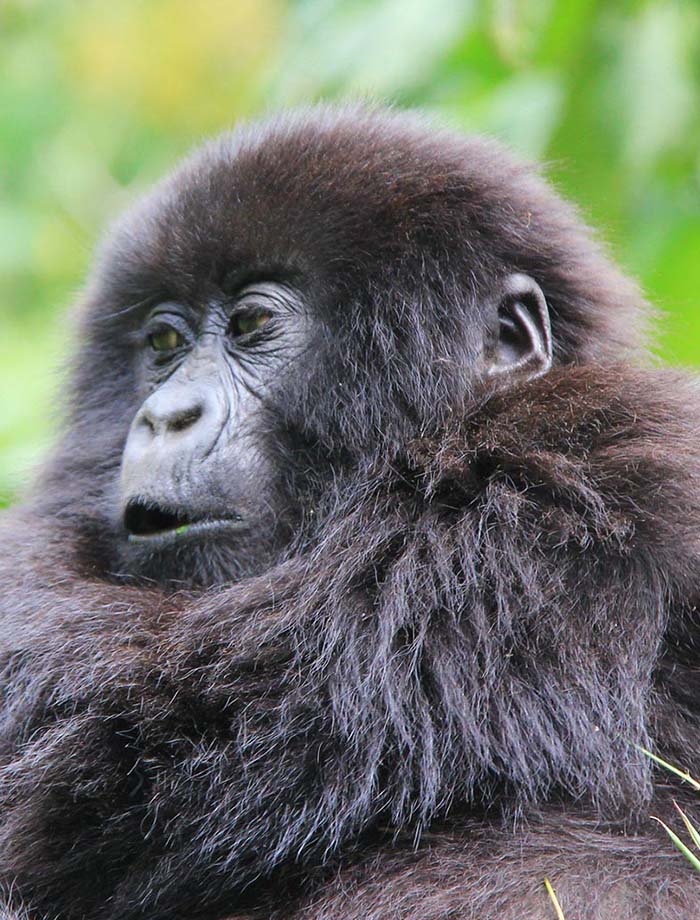Volcanoes National Park
Volcanoes National Park is at almost 15,000 feet covered with rich green rainforest in the Virunga Massif. Volcanoes National Park was named after the chain of dormant volcanoes making up the Virunga Massif: Karisimbi – the highest at 4,507m, Bisoke with its verdant crater lake, Sabinyo, Gahinga and Muhabura.
Situated in the far northwest of Rwanda, Volcanoes National Park protects the steep slopes of this magnificent mountain range of the endangered mountain gorilla and a rich mosaic of montane ecosystems, which embrace evergreen and bamboo forest, open grassland, swamp and heath. Mountain Gorilla Trekking is the most fascinating activity, with over 40 gorilla permits issued each day, a maximum of 8 people are allowed to visit each of the habituated gorilla groups alongside the endemic golden monkeys living in this park.
Uganda and Rwanda offer the best destinations for Gorilla Safaris in Africa. Gorilla tourism is very important to these two countries and they do their best to maintain a safe environment so that their tourism industries can flourish.
There is a set of rules and guidelines to follow when you go gorilla trekking, for safety purposes the gorillas that are tracked and visited have been habituated to tolerate human presence.
Vegetation and Wildlife in Volcanoes National Park
Volcanoes National Park comprises distinctive vegetation zones located in areas or varying elevations. These have different plant species unique to the area. From 2400-2500mters above sea level, there exists the lower montane forest which mostly includes pristine farmlands. From 2600 – 3200 meters, there thrives a Neoboutonia forest and Bamboo forest which forms only 30% of vegetation in this altitude, followed by Hagenia woodland, and then Hypericum zone exists. At 3500 to 4200m there is Lobelia zone and from 4300-4500m there is a thicket, mashes and non woody plants (grassland).
Alongside the mountain gorillas, the park is home to various animals including, Forest elephants, buffaloes, bush pigs, giant forest hogs, duikers, spotted hyenas, bush-bucks and several primates.
Mountain Gorillas
Volcanoes National park is home to the endangered mountain gorillas, the Park has 10 habituated families of these endangered species of gorillas for tourists to visit. Tracking the Mountain Gorillas is an adventurous and a memorable opportunity that leaves reminiscences of the entire expedition. A face to face encounter with these Giant Apes is such a wonderful and exciting moment .
Gorilla Groups in Volcanoes National Park
There are several gorilla families in volcanoes national park, to track gorillas, you need to purchase a gorilla permit before embarking on this experience. Each gorilla group is given a name depending on different circumstances and is led by a silverback.
Amahoro gorilla group – Amahoro means “peaceful” and is led by the calm Ubumwe. The group mainly resides uphill which requires you to endure a steep climb to eventually come into its territory but as always, the climb is worth it.
Hirwa gorilla group emerged from different existing gorilla families including Group 13, Susa and Sabyinyo. Munyinya the silverback after leaving Susa with 2 females, got others along the way and eventually formed a group.
Sabyinyo gorilla group is lead by Guhonda, named after one of the volcanoes – Mt Sabyinyo. The members within this family are generally fewer but is an impressive family. This group is closest to the park headquarters, if you are weary of tracking long distances, this is the group to request if available.
Kwitonda gorilla group is led by silverback Kwitonda and the name is translated “humble one”. This gorilla group migrated from Democratic Republic of Congo and settled ‘permanently’ in Rwanda. It is moderately difficult to trek because it ranges far in the upper slopes of Mt Muhabura.
Group 13 / Agashya gorilla group had only 13 members during habituation hence its name. Currently it has a membership of approximately 25 members and is led by silverback Agashya which explains the name change.
Umubano gorilla group is led by silverback Charles who broke off from Amahoro gorilla group with some females to form Umubano. The name Umubano is translated ‘living together’.
Ugenda gorilla group was named after its unique behavior of roaming from place to place around the Karisimbi area, come ready to hike this volcano as you follow this gorilla group.
Susa (A) gorilla group is the largest gorilla group in the park with 41 gorillas and is the group which was studied by Dian Fossey. The group is known for having the rare twins named Byishimo and Impano. This family ranges in the high mountains making it difficult to trek, but rewards you with its size on sighting it.
Karisimbi / Susa – B gorilla group split from the original Susa (A) group and has 2 silverbacks. This group is one of the hardest to trek, residing on the upper slopes of Mt Karisimbi. It is best for seasoned hikers who enjoy the hiking experience as much as sighting the gorillas.
Titus gorilla group was named after silverback Titus which was born during the days of Dian Fossey’ research at Karisoke.
Bwenge gorilla group was formed by silverback Bwenge after breaking away with females from other groups. Bwenge is translated ‘Wisdom’. The group occupies mainly the slopes between Karisimbi and Bisoke mountains.
Birds of Volcanoes National Park
Volcanoes national park is home to over 200 bird species with a number of Albertine rift endemics for bird watching enthusiasts to enjoy. Birding is the next best thing to do in this park after mountain gorilla tracking and golden monkey trekking. Some of the species to look out for include, Grauer’s rush warbler, Rwenzori batis, Rwenzori turaco, Rwenzori double –collared Sunbird, handsome francolin, strange weaver, dusky crimson-wing, collared Apalis, red-faced woodland warbler and Archer’s ground robin.
Activities/ Attractions in Volcanoes National Park
Volcanoes National Park is one of the most frequented parks in Rwanda with its major attraction as the mountain gorillas in their natural habitat though there is more to this park than just Gorilla Trekking.
Gorilla Trekking
Mountain gorillas in Rwanda are the most exciting and unforgettable wildlife experience that is very rewarding. The forested slopes create a dramatic natural background which is very breathtaking.
Coming face to face with the mountain gorillas is a very thrilling experience, and also trekking them in the damp misty vegetation offers you an amazing experience that will remain forever memorable and bring you close to the reality of these great apes.
Golden Monkey Trekking
The beautiful golden monkeys with orange bodies plus sleek back heads plus legs. Actually they spend most of their time within the bamboo zone feeding on bamboo shoots, stay in groups of utmost 40 individuals, they squeak and tweet all the time while they feed on the vegetation of the park.
Birding safaris
This park hosts over 90 bird species among which are 13 species endemic to these Virunga plus the Rwenzori mountains; like the Rwenzori turaco which is among the most beautiful birds within these montane forests, and the handsome francolin among others.
Hiking the Dian Fossey Tomb
Dian Fossey conducted her life time dedicated work concerning the survival of the Mountain Gorillas which actually resulted into a movie titled “Gorillas in the Mist”, which opened the world’s eyes to these gentle giant creatures and worked hard to the protection of this species which was at the edge of being extinct and whose habitat was being destroyed.
Mountain hiking and Nature walks
The best way to explore and experience this park is by taking a Mountain hiking or nature walks offering you a better glance of these Virunga mountain chain as well as learn the ancient stories about them. These high mountains offer some of the finest views within Rwanda.
Cultural Encounters
You will get a chance to visit the Ruhengeri Market, offering you a chance to see as well as buy some of the local Rwandese’ fabric as well as marvel at how well these local markets are structured.
You will get a chance to visit a number of local projects, see how your contribution towards the local communities is best trekking put to use to better the lives of the local. Also have an opportunity to interact with the local project members and even share ideas.
You will get a chance to learn some of the traditional dances offering you a better way to experience the intriguing local culture.
You will get a chance to taste some of the local food and locally brewed beer.
You will visit some local households and have hands on lifestyle experiences, to actually learn more about the day to day lifestyle of the locals.
You will visit the twin lakes of Lake Ruhondo and Lake Burera to view the Virunga mountain chain.
Accommodation in Volcanoes National Park
Volcanoes National Park is well protected with forest rangers that ensure that you have the very best of your trip . This is the best place to see the tranquil mountain gorillas with great opportunities for photography. The park has many establishments for accommodation and some of them include:
- Mountain View Gorilla Lodge
- Gorillas Nest Lodge
- Virunga Lodge
- Le Palme Hotel Rwanda
- Kinigi Guest House
- Le Bambou Gorilla Lodge
How to get to Akagera National Park
By Road
Volcanoes National Park is located in Musanze also known as Ruhengeri, which is very accessible by public transport from Gisenyi or Kigali. The drive to Volcanoes national park is 2 hrs with a possibility of gorilla tracking on the same day and driving back to Kigali after the trek.
Best time of the year to visit Volcanoes National Park
Make an Enquiry/ Talk to an Expert
Volcanoes National Park in Pictures
Our Recommended Gorilla Safaris
Our itinerary ideas will give you a starting point for what your trip could entail. Treat them just as inspiration, as each trip is created uniquely for you and there are many more options available.


